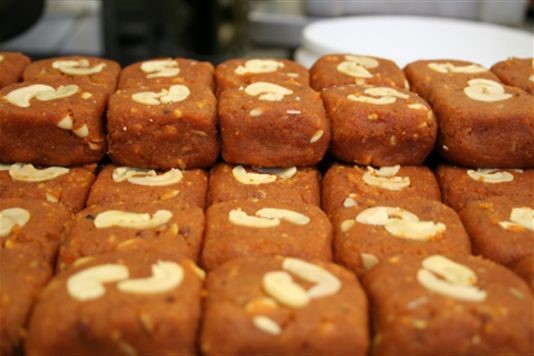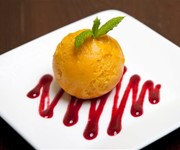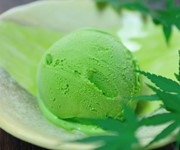Exploring Indian desserts

The Indian subcontinent boasts all kinds of traditional desserts, ranging from kheer (rice pudding) flavoured with rose water and flecked with nuts and raisins, to fudge-like halwa made with ghee (clarified butter).
But somehow Indian desserts have gained a reputation for being too sweet and sticky. Is that true? And if so, how can they be made less sugary, more accessible for the British palate, and yet still resolutely Indian?
Dessert or sweets?
 The custom in the subcontinent is to end a meal not with pudding, but with fresh fruit instead – orange segments, for example, are a cool and refreshing denouement to lunch or dinner in a land where the climate is usually hot. But outside of the subcontinent, people have been served overly rich and sugary Indian sweets for dessert, which is not particularly authentic.
The custom in the subcontinent is to end a meal not with pudding, but with fresh fruit instead – orange segments, for example, are a cool and refreshing denouement to lunch or dinner in a land where the climate is usually hot. But outside of the subcontinent, people have been served overly rich and sugary Indian sweets for dessert, which is not particularly authentic.
For example, gulab jaman and rasmalai – which we often see on Indian restaurant menus – are in fact Indian sweets, and are usually only served at tea time or on special occasions and religious festivals, such as Diwali or Eid.
A twist on traditional sweets
 Abdul Yaseen, head chef at London’s Cinnamon Kitchen (www.cinnamon-kitchen.com), says that he takes inspiration from traditional Indian cooking for the restaurant’s desserts.
Abdul Yaseen, head chef at London’s Cinnamon Kitchen (www.cinnamon-kitchen.com), says that he takes inspiration from traditional Indian cooking for the restaurant’s desserts.
‘What we then do is deconstruct our desserts,’ he adds, ‘and put a completely different slant on them. So you put a twist on traditional sweets by having those old flavours adapted to ice creams, sorbets and compotes. You also have to bring in an element of seasonality and creativity.’
Desserts on the current Cinnamon Kitchen’s menu include saffron poached pear with start anise ice cream; Indian banana tarte tatin; valrhona dark chocolate soufflé with cinnamon cream anglaise and pistachio crisps; and homemade ice creams including flavours such as clove.
‘If you are going to give something an Indian influence,’ says Yaseen, ‘try chocolate with cumin, which is not sweet but nutty, or other spices that give a good hint of the Indian in desserts, like star anise, cinnamon, cardamom or even coriander, which is also not sweet.’
Cut through the sweetness
 Samir Sadekar, head chef and general manager at London’s Soho-based Indian restaurant Imli (www.imli.co.uk), says that whilst most Indian desserts are milk based and very sweet, continental desserts can also be just as fattening.
Samir Sadekar, head chef and general manager at London’s Soho-based Indian restaurant Imli (www.imli.co.uk), says that whilst most Indian desserts are milk based and very sweet, continental desserts can also be just as fattening.
‘The trick is to firstly ensure that you always reduce the sugar content to a minimum in Indian desserts, and then pair them with stewed fruits, ice creams and sorbets such as our popular mango and basil sorbet. Often in Indian restaurants you will see that the gulab jaman, which should be served hot, will be partnered with vanilla ice cream so that the ice cream will cut through the sweetness of the Indian gulab jaman.’
Ice creams with Indian flavours
 At Chilli Pickle (www.thechillipickle.com), an Indian restaurant in Brighton, which has two AA Rosette awards, desserts are a priority and aim to marry the traditional with the contemporary.
At Chilli Pickle (www.thechillipickle.com), an Indian restaurant in Brighton, which has two AA Rosette awards, desserts are a priority and aim to marry the traditional with the contemporary.
‘We make our own Indian sweets in-house, but fully keep in check the sugar we put in,’ says its chef-patron Alun Sperring. ‘But what we excel in is our Indian flavoured ice creams ranging from saffron and pistachio to banana and raspberry lassi ice cream. They go down a treat!'
Comments
Be the first to comment
Do you want to comment on this article? You need to be signed in for this feature